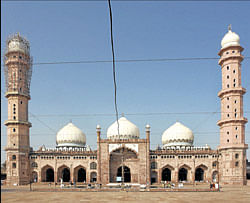Taj-ul-Masajid, though hardly known even in India, is the third largest mosque in the world, and is situated in the old city of Bhopal. Few know that Taj-ul-Masajid was built by Shahjahan Begum (not related to Emperor Shahjahan), who was the 11th ruler of Bhopal in 1868.
She initiated the construction of the great architectural wonder — Taj-Ul-Masajid — based on the pattern of the Jama Masjid in Delhi, which was erected by the great Mughal Emperor Shahjahan. It turned out to be an exact replica of Delhi’s Jama Masjid, at least in pictures.
On November 16, 1868, at a durbar held 17 days after Sikandar’s death, Colonel Meade, the agent to the Governor-General, read out the Viceroy’s proclamation and announced that 10-year-old Shahjahan Begum would be the heir apparent. During her 33-year tenure, Shahjahan Begum presided over a settled reign.
This was mainly due to the momentum of Sikandar’s trail-blazing reforms and the support provided by the British.
Unlike other male rulers, Shahjahan was of a different mould, influenced greatly by her mother and grandmother. She had aspirations of becoming a poetess, loved the sound of music, and was coquettishly feminine. Widowed at the young age of 29, Shahjahan was not averse to being courted by ambitious young men. However, she soon became besotted by one man, who spun a web of charm and allurement around the Begum, and became the love of her life.
The other big mosques of Asia include the Badshahi Masjid in Lahore, Jama Masjid in Delhi, Hyderabad’s Mecca Masjid, and Masjid Tipu Sultan in Kolkata. All these might be bigger than Taj-Ul-Masajid of Bhopal only if open area is included. The Taj-Ul-Masajid of Bhopal covers an area of 23,312 sq ft, with the height of the minarets touching 206 ft.
It was a project of breathtaking proportions, with the expenditure touching Rs 16 lakh in that era. Crystal slabs for the floor, worth Rs 7 lakh, were prepared in England. Ironically, as their polished surfaces would have reflected the forms of the worshippers, their use in the mosque was forbidden.
The mosque could not be completed during the Begum’s lifetime owing to the costs involved. Work on completion of this great mosque started in 1971, through the efforts of donors like Maulana Mohammad Imran Khan. The four feet thick roof of the mosque and other incomplete constructions were completed with the help of donations amounting to about Rs 70 lakh.
Elevated well above ground level, the mosque is visible from a considerable distance, as also from the palaces that surround the three lakes around which the development of Shahjahanabad was planned. Monumental flight of stairs ascends to the high octagonal eastern entrance from the Kaiser embankment, inspired by the Buland Darwaza at Fatehpur Sikri.
The external eastern facade ends in pavilions at the two ends that are set high on octagonal towers. Like the Delhi Jama Masjid, smaller square entrances from the south and north open into the central courtyard for the general public.
The main entrance is 74 feet high. The internal northern part was reserved for women to perform their daily prayer. The western side of the mosque is the prayer hall, with nine doors supported by pillars and roof with 27 hollow domes. The pillars and walls demonstrate beautiful Arabesque and floral designs. An international festival of Iztima for religious and theological discussions takes place every year at Taj-ul-Masajid.
The large prayer chamber, composed mainly of 12 carved sandstone pillars, is surmounted by three domes covered with broken tiles and constructed much later. Seven entrance arches pierce the eastern chamber’s eastern facade, the central one has high planks of red sandstone with marble inlay around the arch. The three arches are framed on either side by smaller arched openings with an entrenched jharokha (parlour) above. Railing crowns the three arches, and is finished by sandstone crenellations.
Two octagonal minarets on either side of the eastern facade go several floors high to provide a vantage point from where the upper lake (several metres away) can be viewed. The domes of the prayer hall are crowned with crystal finials that glitter in the morning sun.
If you happen to visit Bhopal, don’t miss the Taj-ul-Masajid as it’s a structure that’ll get embedded into your memory.
